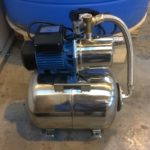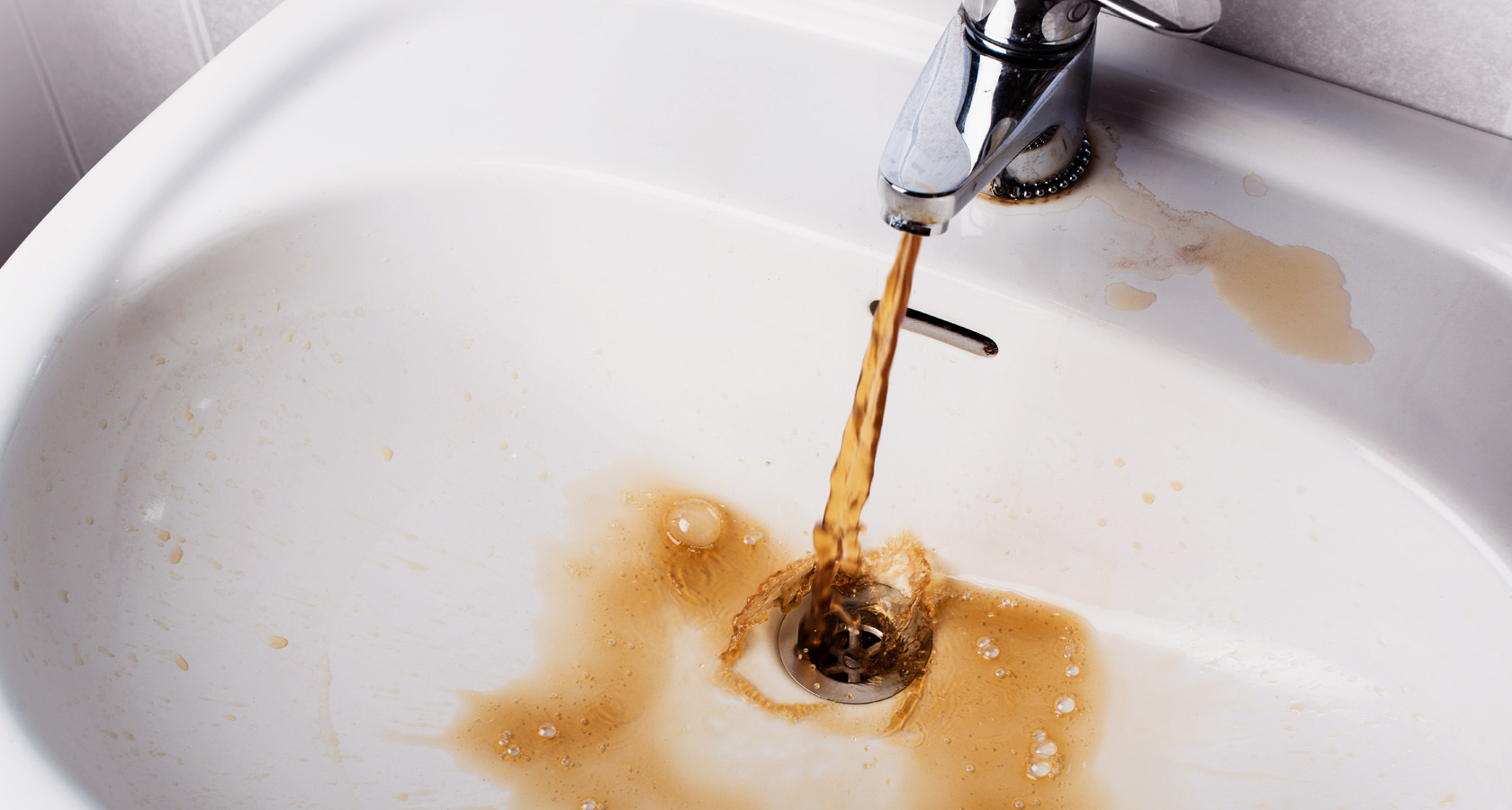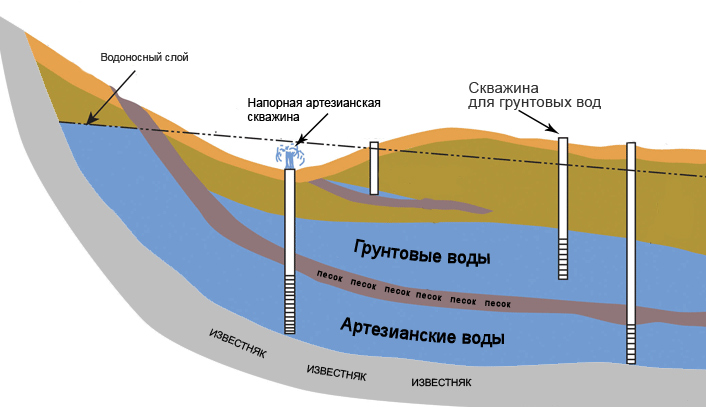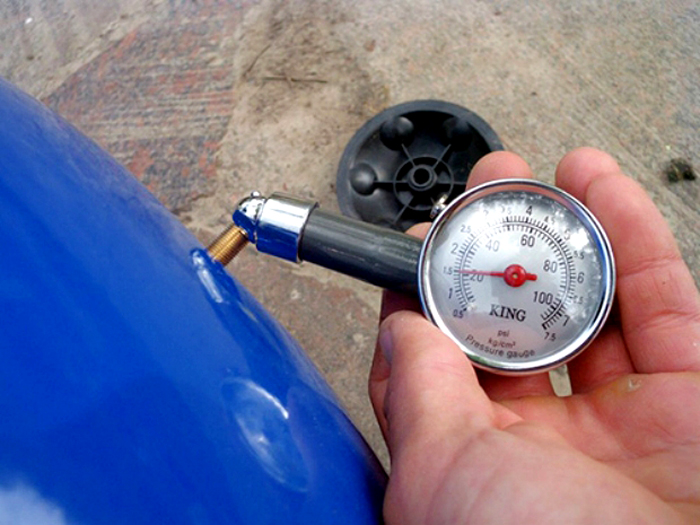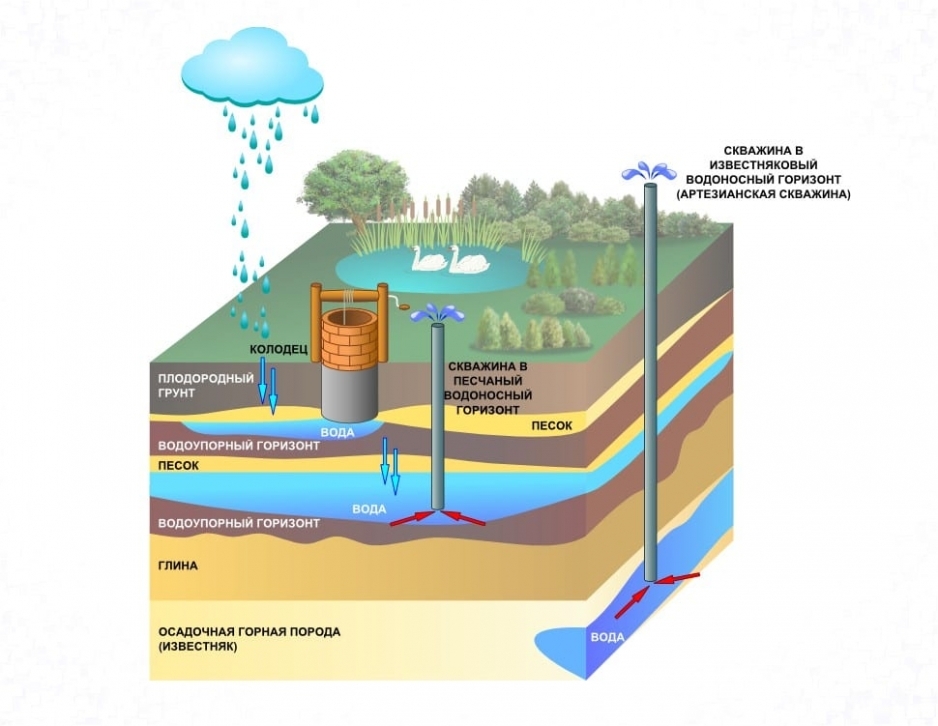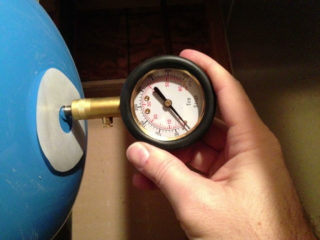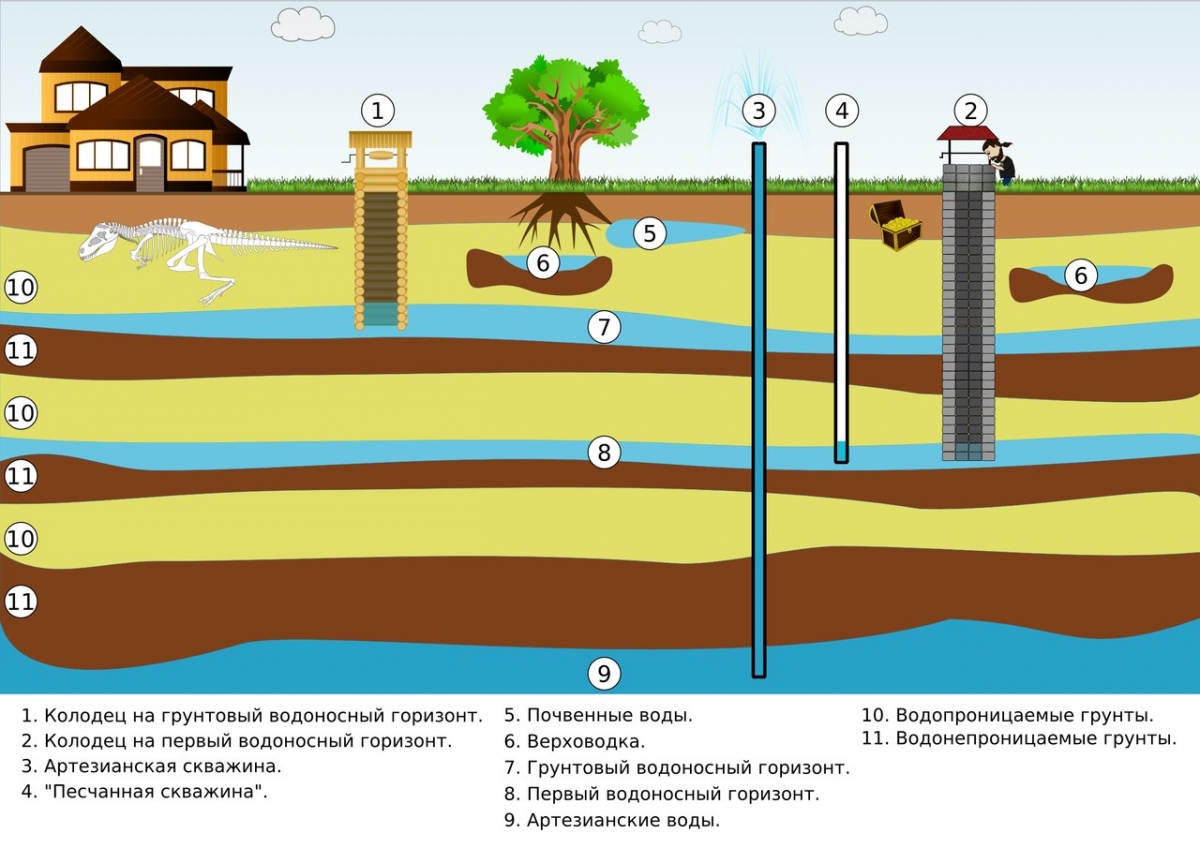To create comfortable living conditions in a country house, you need water supply, sewerage, and electricity. Communications must be autonomous (except for power lines). A water well for a private house is often used as a natural source of supplying a family with a resource. It has a sufficient flow rate, does not take up much space on the site.
Well type selection

To organize the water supply system of the cottage, including a bathhouse, a swimming pool, all plumbing points of the house use a sandy or artesian source.
The first has a depth of 15 to 40 meters, depending on the terrain and the point of occurrence of the aquifer. Before drilling a sandy hydraulic structure, it is advisable to conduct exploratory hydrogeological surveys. The advantages of such a well:
- service life - 10-15 years;
- good quality water that can be drunk right away, often you don't even have to install complex filter systems for iron removal or reverse osmosis;
- the possibility of drilling with your own hands, the process will take from 2 to 5 days;
- productivity - 0.5-1.5 m3 / hour;
- minimal siltation of the source, provided it is located in coarse sand.
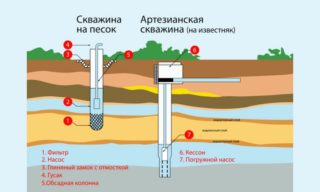
A well on sand can be freely preserved for the winter, if necessary.
The artesian spring has a depth of 50 to 200 meters. The level of occurrence of the aquifer depends on the volume of the resource in the floodplain of the river in a particular region. The well has a high productivity of 2-5 m3 / hour. This allows several large cottages or even a small village to be supplied with water at the same time. Drilling of an artesian source is performed only using sophisticated techniques. In addition, a license / permit is required for this type of well. Artesian spring resources are taxed. Well service life is about 50 years.
Choosing a place for drilling
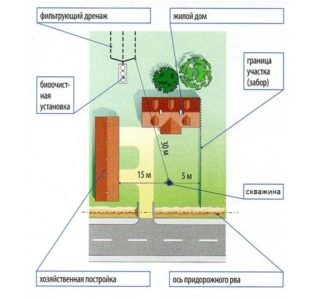
Before installing a water supply from a well in a private house with your own hands, it is important to determine the location of the source. It must meet the following criteria:
- The distance from the residential building is at least 5 meters.
- The distance between the well and the point of discharge of sewage waste should be maximum, but not less than 15-20 meters.
- It is important to preserve the possibility of free access to the source. It may be needed when carrying out repairs or maintenance.
It is possible to determine the location of drilling (the estimated location of the aquifer) with the help of professionals or by external signs. The close location of the underground vein is evidenced by:
- lush vegetation, which is juicy even in the heat;
- an abundance of midges in the desired zone in the evening;
- love of dogs for the location of the aquifer on hot days;
- thick swirling fog in the morning over the aquifer.
Before starting drilling with your own hands, you should prepare a support site. To do this, a small pit 3x3 meters is being dug in the work area. It prevents soil from falling into the mine.
Wellbore formation
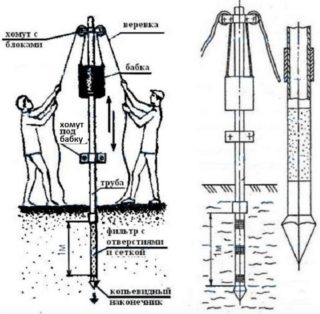
In order to freely conduct water into a house from a well, you must first reach the aquifer yourself or with the help of professionals. To do this, use the following drilling methods:
- Auger. It implies a gradual deepening around its axis of the installation with rounded blades and excavation upward. It is used to drill a shaft in soft sandy clay soils.
- Shock rope. Here, a heavy steel sleeve with sharp edges-teeth and a closing flap is used. The glass is sharply lowered into the ground from a height of 0.5-1 m. Thus, it captures part of the soil into its flask and raises it up. The liner flap prevents soil from spilling out.
- Rotary drilling with parallel water supply to the mine for washing it.
For independent wire rope drilling, it is advisable to mount the winch on a tripod. It will automatically lift the mass of the nozzle with the soil to the top.
The formed mine is equipped with a casing string. It is made from thick-walled plastic or steel pipes. The sections are connected by means of a thread. The very first section of the column (bottom) is made perforated. Small holes 5-15 mm in diameter are formed within a meter from its lower edge. The step of their arrangement is 3-5 cm. The perforated section of the column is wrapped with a fine-grained mesh. This will be a kind of bottom filter that prevents sand from entering the lower part of the mine.
You can drill a well up to 35-40 m with your own hands. It will be free of charge. Deeper sources are formed using rented special equipment.
Well equipment with pumping equipment
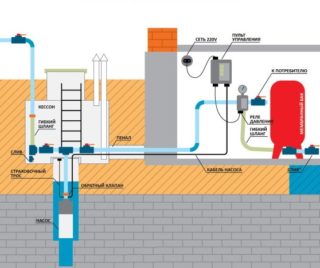
As soon as the source for the house in the village is drilled, the casing is installed, it's time to start installing the water supply from the well. A good pump must be used to supply fluid to the cottage and all other ancillary rooms. It is selected according to the following source parameters:
- total depth;
- the level of the water mirror in the well;
- source performance;
- head: the total length of the vertical and horizontal sections of the pipeline from the point of water intake to the farthest plumbing equipment;
- power - a frequency converter will help reduce power consumption.
One of the types of pumps is used for drinking wells:
- Surface. Delivers water from a depth of 8-9 meters. Ideal for sources that are also called Abyssinian. They are drilled on the top. But such a facility does not have a large production rate. More often the capacity is about 0.3 m3 / hour.
- Submersible deep. It pumps water from a different level of the source from 20 to 150 m. It has the form of a cylinder, which is placed in the casing. The price of a submersible unit is always higher than that of a surface unit.
Additionally, it is recommended to equip pumping equipment with a hydraulic accumulator. The storage membrane tank maintains a stable pressure in the system, eliminates the presence of air in it. In the event of an emergency power outage at the site, the family has a water supply for 1-3 hours, depending on the volume of the accumulator. The optimal volume of the tank is 50-150 liters for 3-4 people living in the house. A detailed diagram of the water supply of a private house from a well with a hydraulic accumulator:
- submersible submersible pump;
- downhole adapter (the device looks like a dovetail);
- hydroaccumulator;
- check valve;
- pipeline from the tank to the house.
All elements are assembled sequentially into one system using high-quality sealant.
Installing the pump
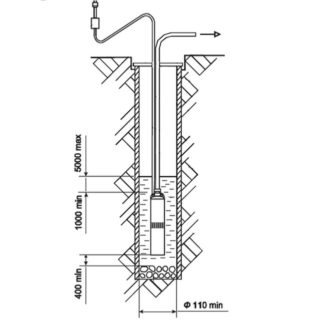
The submersible submersible pump is mounted as follows:
- A water supply pipe is attached to the outlet pipe using a fitting. Its length should reach the location of the downhole adapter.
- In parallel on the ground, lay the electric cable of the pump and the safety cable. It is advisable to take not steel, but strong nylon.
- All three elements (cable, pipe, cable) are tightened with clamps in increments of 1 m. Strong tension or sagging of each of the fastener components should be avoided.
- A technical hole is made in the casing below the level of soil freezing for the outlet of the borehole adapter. Its back is mated to the water intake hose and inserted into the connector. From the outside of the casing, the first part of the adapter is connected to the front and well tightened.
- A piece of pipe is connected to the element, which will lead to the accumulator.
It is advisable to mount all pumping equipment and automation in a caisson - a protective chamber near the well. The reservoir is made at a depth below the freezing of the soil. The parameters of the caisson are 1x1 m or more (at the request of the master). The caisson is made of monolithic concrete, brick, reinforced concrete rings. The best option is to install a factory plastic tank with a top hatch.
Hydraulic tank installation

The storage tank is placed in the caisson, connected to the water supply pipe. One check valve must be installed at the inlet to the tank and at the outlet. Their connection prevents the outflow of water from the system.
The step-by-step principle of the drive is simple:
- When filling the tank chamber, the diaphragm baffle leads to a change in pressure (its increase).
- At this moment, the pump is turned off.
- As soon as the taps in the house open, the liquid leaves the accumulator, and the pressure in it drops.
- When the atmospheric indicator drops, the pump turns on again, replenishing the water in the tank.
In order for the on / off cycles of the pressure equipment to be normal, the operating pressure is adjusted. To do this, a self-made station must be completed with a pressure gauge with a sensor and a relay. The lower pressure limit is 1.5 atm. Upper - 3.5.
At the exit from the hydraulic tank, a pipeline is pulled from the caisson to the house.
External water supply
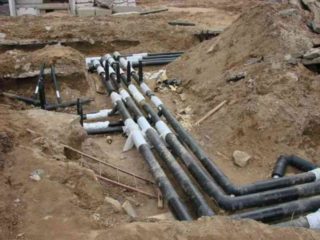
When arranging a water supply system for a private house from a well with a hydraulic accumulator, it is important to properly lay the pipes outside. The best options are HDPE products. Low pressure polyethylene withstands temperature changes well, is easy to install, resistant to deformation.
To lay pipes, you need to dig a trench from the caisson to the foundation of the cottage, pool, etc. The depth of the channel is below the level of soil freezing. This parameter is often 0.8-1.5 m, depending on the region.
Docking of pipes is carried out using special electric couplings. When heated, they melt the HDPE material and make the joints tight.
It is better to lead the line into the house through the foundation. Here you should make a hole using a perforator crown. It is reinforced with a steel sleeve. The introduction of water into the house from the well is hermetically sealed, additionally all the gaps are coated with bitumen mastic.
It is also necessary to introduce water pipes below the freezing level of the soil.
Internal piping layout

There are two ways to run the water supply around the cottage:
- Consistent. Each plumbing fixture has its own water supply branch from the main tube. The disadvantage of this method is a decrease in pressure in the system while simultaneously opening two or more taps. Plus - saving consumables.
- Collector. Each type of equipment is connected to its own separate pipe. The disadvantage of the method is the painstaking work and a large amount of consumables. Plus - stable pressure in the system, regardless of the number of open valves.
For piping in the second way, a manifold adapter is used.
For internal water supply, it is better to use polypropylene tubes or PVC products. They are assembled using fittings. Polypropylene is mounted by soldering.PVC - using special adapters. For drainage pipes, special sockets with a seal are provided.
Before starting the water supply in the country or in the cottage, you need to fill the accumulator with water. It is important to check all connections for leaks before fully operating the system.
If autonomous water heating is required, it is advisable to buy and install a water boiler.
Water pipe insulation

In order to further protect the system from the problem of freezing, it is important to take care of the use of insulation materials. The most optimal is a heating cable. It is mounted along the entire highway outside in one of the following ways:
- Linear. The cable is pulled along the pipe from the well home parallel to its position. The fixation is carried out in stages using construction clamps and an assembly fiberglass self-adhesive tape. With this method of laying the cable, its consumption is reduced. But the method is suitable for small diameter pipes. Otherwise, the heating of the entire surface of the highway will be inadequate.
- Spiral. According to the instructions, the cable is wound around the pipeline. The smaller the section of the pipe, the greater the pitch of the turn. For example, for a line with a diameter of 100-150 mm, you can wind a spiral with a step of 7-9 cm.
With any method of cable laying, one nuance should be taken into account - you need to use a protective upper thermal insulation. Otherwise, heat loss cannot be avoided, the line will still freeze through. A shell made of foamed polyethylene or expanded polystyrene is used as a casing.
Drainage in a private house

For the full functioning of the home water supply system in a country house or cottage, a sewer pipeline should be installed. The cross-section of the line depends on the total volume of discharged wastewater. But for domestic sewage, they often take tubes with a diameter of 150-200 mm.
The main requirement of SNiP is that pipes are laid with a mandatory slope towards a cesspool or septic tank. This eliminates the malfunction of the system. According to the norms, the slope indicator changes depending on the cross-section of the pipes. For a diameter of 200 mm, the level is 0.8 cm for each linear meter of the line. With a decrease in the cross-section of the sewer, the level of the slope increases.
The drainage system is also mounted below the level of freezing of the earth. If this cannot be done due to the peculiarities of the relief on the site, it is important to provide for high-quality insulation of the highway. It is undesirable to conduct / bring the sewer along the top on the street. Otherwise, the system will constantly freeze. Or, with this method of installation, a high-quality insulation is used.
By law, it is prohibited to install open (leaky) cesspools on a plot in the yard. This leads to an environmental disaster, pollution of the underground waters of the village. As a sink for drains, it is better to arrange a homemade septic tank for 2-3 chambers and remove waste into it. Many consumers / craftsmen prefer to install a factory cleaning tank. This is a plastic container with stiffening ribs. The places where the collector is connected to the tank are reliably sealed to avoid leakage of drains into the ground. A sealed septic tank does not allow a specific smell and qualitatively cleans the drains before they are drained into the ground.
Before performing all installation work, you should prepare a schematic drawing of the communications laid on the street. On it, it is worth indicating the places of piping / branching of pipes, turns of the main line, the points of location of revision, drop wells. Such schemes make it possible to quickly carry out repair work in the future, if the need arises. The foreman will know where the pipeline runs through the section and at what depth it is.
If it is difficult to cope with the installation of the water supply system on your own, you can order turnkey work. Specialists dig a well / drill a well and completely organize their arrangement to provide the whole family with water, and the vegetable garden with resources for irrigation. Then they instruct in detail on the principles of well operation.The average cost of such works in Moscow is from 2,500 rubles. per running meter, taking into account the casing. How much it will cost to complete the full scope of services will be shown by the estimate previously drawn up by the masters.

